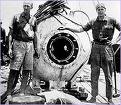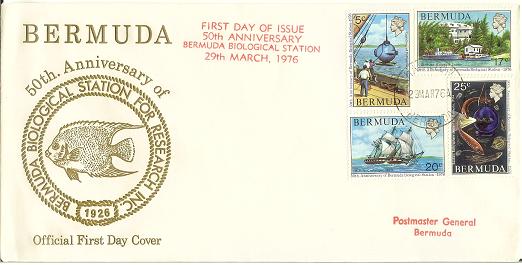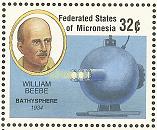|
Charles William Beebe ‘Bathysphere’, 1934
 Charles William Beebe (1877 - 1962) is most famous for his world record descent in the Bathysphere-bathys is Greek for "deep"- with Otis Barton in 1934. Beebe also wrote popular books about his exploring experiences working with the New York Zoological Park (Bronx Zoo). Charles William Beebe (1877 - 1962) is most famous for his world record descent in the Bathysphere-bathys is Greek for "deep"- with Otis Barton in 1934. Beebe also wrote popular books about his exploring experiences working with the New York Zoological Park (Bronx Zoo).
On Wednesday, August 15, 1934, William Beebe and Otis Barton made themselves world famous by descending in their "Bathysphere" 3,028 feet beneath the ocean surface-off the coast of Bermuda.
William `Will` Beebe began exploring the undersea world with his homemade diving helmet April 9, 1925. He writes about those and other dives in The National Geographic Magazine ("A Wonderer Under Sea," Dec. 1932).
He encouraged others to join him in the `Society of Wonders` in what he called the `Helmet Kingdom`.
William Beebe dreamed of exploring the deeper locations where he and his air hose tether could not reach. He said that based on "sketchy recollections" with Colonel Theodore Roosevelt, the idea for a spherical deep-sea vessel came from Roosevelt who drew a sketch on a napkin while the two chatted together about exploring the ocean depths.
Since Beebe was already a pretty well known figure from his popular books, his newest inkling of exploring the deep blue sea in a submersible chamber was published in a New York newspaper in late 1926. Soon Beebe`s office was deluged with crackpot designs and strange drawings, proposing all sorts of devices. Those who knew Beebe knew that he wanted nothing elaborate or overly mechanical. He once said that although he knew how to drive, he disliked even driving a car. Beebe wanted something simple, so informed a mutual friend of his and Beebe to Otis Barton.
Otis Barton was a wealthy single guy with a passion for exploration as well. Barton had an engineering background and was attending postgraduate studies at Columbia University. Like Beebe, he too had explored shallow waters with his own wooden diving helmet, at the bottom of Cotuit Harbor in Massachusetts. Besides having a restless spirit similar to Beebe, Barton also had in his hands a substantial amount of money that he inherited from his grandfather. Barton decided to design a deep sea vessel that could take him into the deep ocean realms. However, at around the same time, Barton read of Beebe`s plans to build his own deep sea device in the 1926 Thanksgiving Day edition of the New York Times.
Barton`s hopes were dashed. But Barton felt Beebe`s device, shown in the paper, looked like a `laundry boiler` and was a bit skeptical at its actual feasibility. He was still worried that he would be `seconded.`
Barton asked a newspaper friend of his that was also a friend of Dr. Beebe, to get him an introduction. The mutual friend told Beebe, "You`d better see Otis`s blue prints unless you want to lose out in this deep-sea exploration business." Beebe`s reply was "Another gadget!" But Beebe agreed to meet with Barton. On time for his momentous appointment that Dec. 28, 1928 day, Barton nervously brought his blue prints to the New York Zoological Park, not knowing if he would immediately be shown the door.
Barton described Beebe as being tall and vigorous and who greeted him crisply at the door. Barton laid out his blue prints on Beebe`s desk and explained his idea. Now, Beebe had already seen all the fancy idiotic plans that had been sent his way since the 1926 article, so he was in the mind set that he wanted something simple and practical, not something out of an H.G. Wells book. The design which immediately caught Beebe`s eye was indeed Otis Barton`s simple round sphere. It was an ideal concept, making it so the strong pressures of the deep sea would be equally distributed if the vessel was shaped like a ball.
The Bathsphere
It was a 4,500 pound (some 2.5 tons) hollow steel ball about five feet in diameter, (the inside was 54 inches wide, the steel was 1½ inches thick), which was raised and lowered from a ship by a cable. Because of the attached steel cable and winch, the Bathysphere wasn`t very maneuverable; it could only go straight down and straight back up again.
 It would be tethered from a mother ship at the surface of the ocean by a single, non-twisting cable 3,500 feet long. The steel cable, made by Roebling, would be seven-eighths of an inch thick and would have a breaking strain of 29 tons. Another 100 strands of cable would be interwoven around the steel central core to ensure it would not rotate the sphere upon descent or return to the surface. The part where the cable attached onto the Bathysphere`s top swivel was fused with white metal. It would be tethered from a mother ship at the surface of the ocean by a single, non-twisting cable 3,500 feet long. The steel cable, made by Roebling, would be seven-eighths of an inch thick and would have a breaking strain of 29 tons. Another 100 strands of cable would be interwoven around the steel central core to ensure it would not rotate the sphere upon descent or return to the surface. The part where the cable attached onto the Bathysphere`s top swivel was fused with white metal.
Electricity for light and a telephone line were wrapped inside a rubber hose which entered through a small hole at the top of the Bathysphere. The hose would be tightly sealed using a large `stuffing box`, which would prevent water from entering the sphere; it was Barton`s responsibility to maintain it.
Oxygen tanks with automatic valves were installed. Trays of calcium chloride (to absorb moisture) were placed on specially built racks alongside trays of soda lime (to remove excess carbon dioxide). The occupants would be sealed inside using a 15", 400-pound circular `door` put in place by a winch and then hand tightened with ten large bolts. The entrance was so small; Beebe and Barton had to squeeze their way into and out of it headfirst. Then a large 8" wing bolt would then be set in place and tightened, covering the remaining tiny hole in the door.
There was room for three 8" diamiter port holes, but the third was plugged. A 250watt spotlight (later it was replaced with a brighter light) was affixed over the starboard porthole. The remaining two cylindrical windows were made of heavy-duty fused quartz, 3" thick.
Back to History Index
 |
Bermuda |
1976 |
50th anni` of Bermuda Biological Station, 29 March, 1976 |
 |
Bermuda |
1976 |
Beebe's bathysphere descent off Bermuda 1934 |
 |
Bermuda |
1976 |
Launching of bathyspere from the Ready |
 |
Bermuda |
1976 |
50th anni` of Bermuda Biological Station 1976 (set of 4 stamps) |
 |
Palau |
1995 |
Beebe Bathysphere 3,028 feet |
 |
Micronesia |
1997 |
William Beebe, Bathysphere 1934 |
 |
Palau |
2000 |
Bathysphere, 1934 William Beebe and Otis Barton dive to a record of 3,028 feet |
|